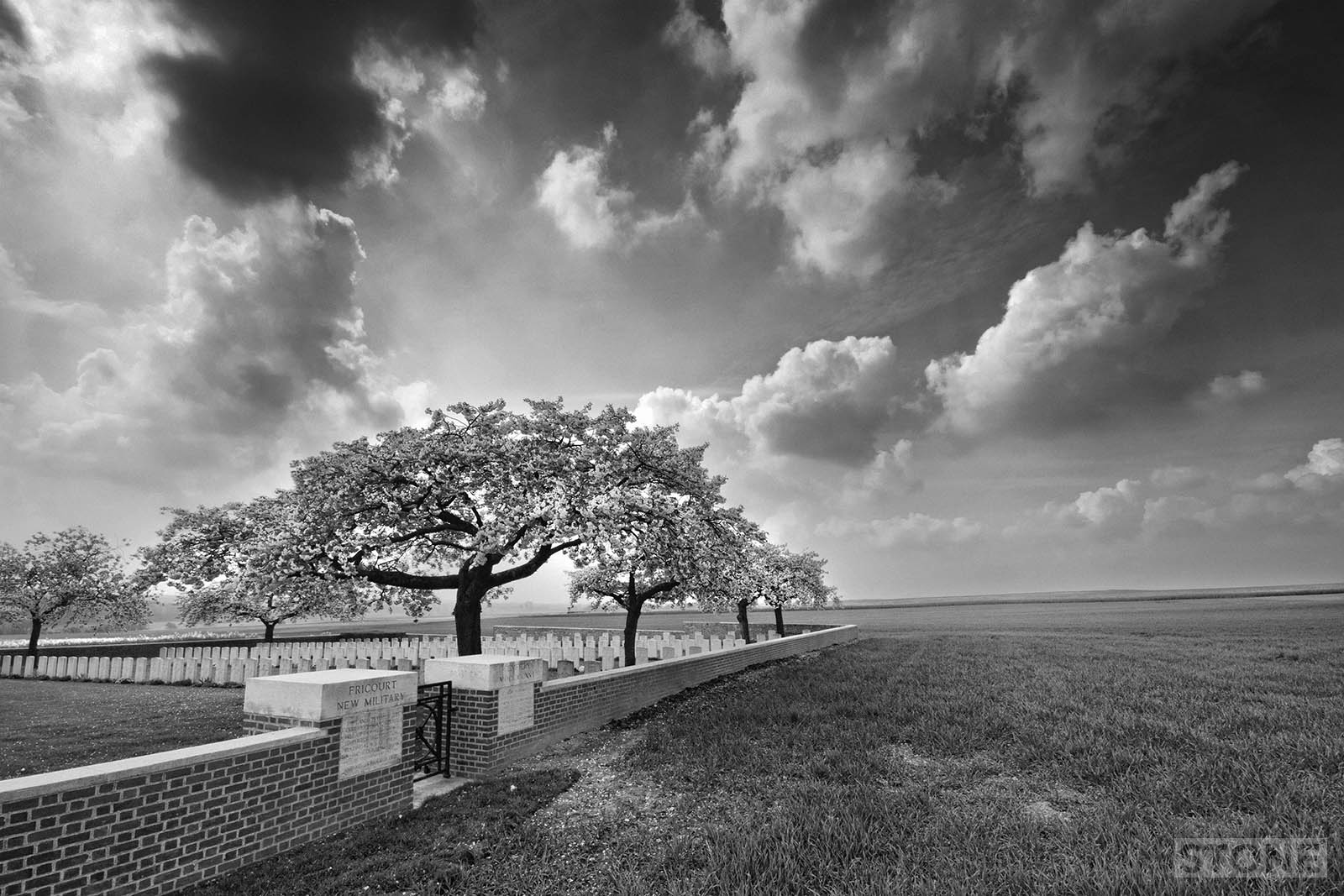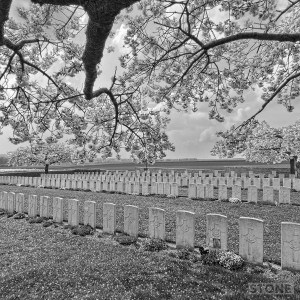The best and the worst of it all are hidden over a brow. You won’t find the chattering crowds of the nexus points where death draws itself to a peak, this is not Thiepval or the Menin Gate. Nobody talks, no one sniggers, there is no rustle of frite wrapper when a hush is drawn. No dignitaries nor men in tidy suits with their furtive mobile phone glances or the stutter of shutters in a forest and waved tablet and phone cameras. This is the mud of winter that sticks to the boots, the dust of summer that sticks in the throat and eyes, it’s the lost, the truly lost of the old front.
I stumbled across Fricourt New Military by a combination of luck and chance. We stopped at La Boisselle; the Lochnagar crater on the way home from somewhere else, a quick saunter around the yawning dent in the land before a night of books and the bar. There was a man, a northerner with his son, just us and them. His lad showed us his field finds, an ice cream tub of shrapnel balls, bits of strap and buckle and one bent bullet head, his favourite thing grubbed from the riddled dirt above the sleeping seeds just beyond the pile of marl where the coaches park up in summer like cows in for a feed. We chatted briefly, his voice thick like treacle parkin. He asked me where we’d been, had we ‘got up to Fricourt this trip yet.’ I answered Yes, ‘always go and have a look at the German lads, worth a thought too aren’t they.’ ‘Yes, but that’s not what I meant, I meant the little one up in the fields, it’s the best one on the front, my favourite of them all, local boys for us aren’t they son.’
He looked at his boy with his box of rust and lead and dirt. Then explained where it was, hidden up behind the scrubby bit, dog-legged off the road. ‘I’ve got no family in it but there’s lots of lads from Hull, York and Leeds, a bit of a shrine, like you and the Norfolk’s cemetery I should think’. He’s right of course up near Becourt there is a strip of field originally set up for our local boys and men, then filled with wanderers until the war closed over them all; the rumble of the shells becoming the whirr of the lawnmower. His eyes glistened as we shook hands and went back to our cars.
Fricourt is already an extraordinary place in time, the German concentration cemetery haunted by Teutonic symbolism, neat and faintly severe with its thin black regimented markers, and the back wall which marks the mind-numbing collected remains of the concentration burials. There are a handful of these burial grounds on the French sector of the Western Front, this one once numbered amongst it’s ranks Baron Manfred Von Richtofen before his restless return to the fatherland. It looks out across the fields, a hard fought spot in the landscape marked by the human tide for perpetuity in our slow forgetting.

Back down the road towards the quietness of the village there is a metalled track, you can fit a car up it to a point, but sense says walk, it’s not that far. And on a dry day in the sun it’s a pleasant thing to kick up the dust with your feet, drift past the utilitarian bungalows and out into the fields, become out of sight. The road almost peters out at a split, dust to the right, a ridge of turned clods, a grass track with tractor cut ruts leads up to the horizon, and on your left, a few hundred yards along and down a narrower track sits a garden walled in brick, cherry trees hunched over, the familiar cross of sacrifice hiding in between the yew trees. These corners are the places to go, there are thousands like it. It is a much more solitary place to see and understand the front and the tidal waves of conflict shifting and stalling in the landscape around you than teh big cemeteries, a thin slice of what went before.
I’m still always amazed and disturbed when walking down to these places how little tuning of the eye it takes to see the remains of hell in the soil, the orange twisted lumps of shattered shell in between the clods or sticking through the raked surface between the maize, rapeseed or wheat. This is no different, the iron content visible in the soil. The ploughs cut in near the edges of the walls that hold the dead, a heavy gate and then the memorial book, then the rows.
 Fricourt New Military is just behind the Tambour mine site, a piece of private ground still marking where the mines that were set off near the German line on the first day of the Somme. The idea was to protect the British lines from fire from the village, the lip thrown up blocking the view across. Perhaps these unequal rows show a tactical failure on that front, there are a lot of men here.
Fricourt New Military is just behind the Tambour mine site, a piece of private ground still marking where the mines that were set off near the German line on the first day of the Somme. The idea was to protect the British lines from fire from the village, the lip thrown up blocking the view across. Perhaps these unequal rows show a tactical failure on that front, there are a lot of men here.
What strikes you most is the Yorkshireness; it is as the man at Lochnagar suggested; a piece of the North, Sheffield, York, Blackburn, Rotherham, and Leeds; from Barraclough and Blatherwick to Wanless and Waddington, aged 18, 20, 23, 26. More striking still and more unsettling is the date on the headstones. There are a handful of Devonshires in here from later in the month, but the vast majority are the Yorkshire lads, all died on the 1st of July 1916, wiped out in the advance across the dry Somme dirt. They were buried together in four graves, some are two to a marker they lay so close. That sudden realisation as you stand there near an old ploughed in front line is that this place marks the result so totally it makes clouds gathering on the horizon empty in your heart.
Walking back up on my own staring out across the fresh crops I met a man coming down to visit, His car half-cocked, pushed up on one side at the end of the narrow path. ‘My mistake’ he said ‘how do I turn round?’ I smiled ‘I don’t think you can turn back from here, I’m not sure you can reverse either’. He smiled and shrugged. ‘You looking for the Yorkshires?’. I ask, ‘No mate, there’s a Kiwi in there on his own, I’m a volunteer, we’re visiting all of them, taking a photo of each New Zealand Grave, put them online so people at home can find them. Did you spot him, a pioneer?’. I confessed I hadn’t, my lens so smeared at times.


Thanks for your wonderful photograph and this evocative piece of writing. It brought back to me standing in Fricourt New when I was working with a battlefield guide in November 2014 tracing my Great-UncleE.J. Britton’s war. He started in sector D3 in September of 1915 with the 12th Middlesex Regiment.